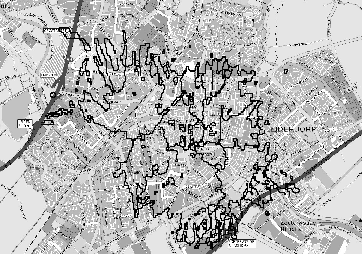
The total number of people living in this area is approximately
160,000. In this area we want to provide outdoor coverage. For using
the network indoors, a small antenna connected to the client computer
has to be sufficient. The antenna should preferably have a line of
sight to the nearest network access point. This is required as the
maximum distance between the client and the network access point (a
network node) is limited due to the national legislation implementing
European (EU / ERC) regulations (restricting maximum radio frequency
output power and restricting antenna gain). Combining this knowledge
with the anticipated traffic and bandwidth needs, it is evident that we
need multiple nodes distributed over the coverage area. The nodes
themselves have to be interconnected. A plot of the radio coverage of
the current set-up (the historical center of Leiden (![]() )) is
shown in figure 1. To provide full outdoor coverage of
the target area an estimate of 25 network nodes will be needed.
)) is
shown in figure 1. To provide full outdoor coverage of
the target area an estimate of 25 network nodes will be needed.
 |
A mesh between the nodes will be formed, as each node is connected to the other nodes by at least 2 different (wireless) connections. With this approach, adding extra nodes to the network will add redundant paths and will therefore also increase the total available bandwidth. The topology as seen from the user is comparable to cellular telephony. Cells for users are created. In these cells the users share the total available bandwidth of an access point. The cells themselves are interconnected by point-to-point wireless connections. These connections form the backbone of the network.